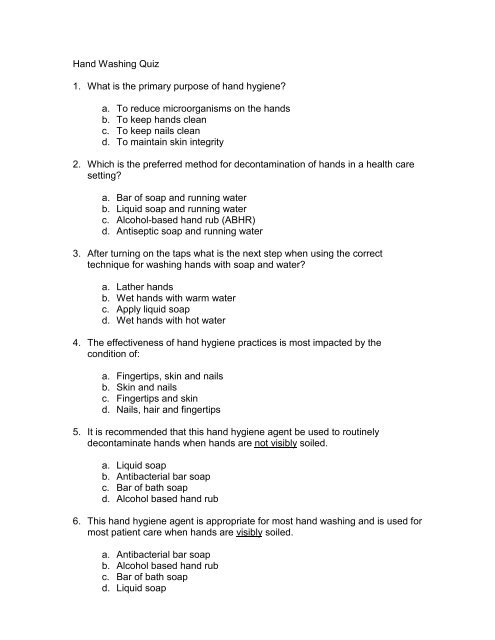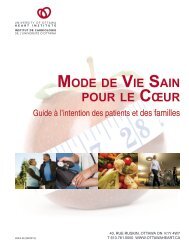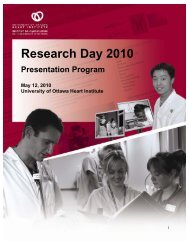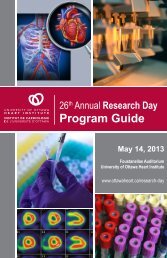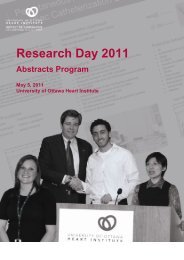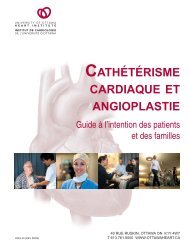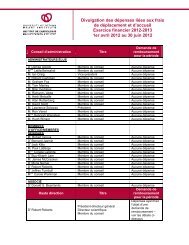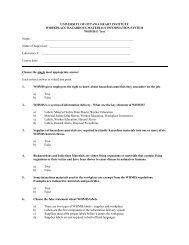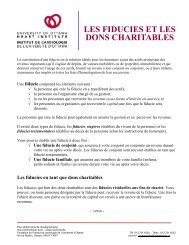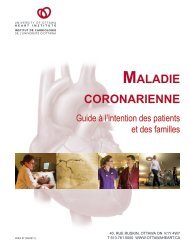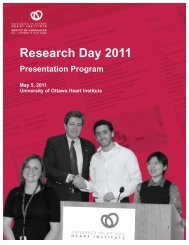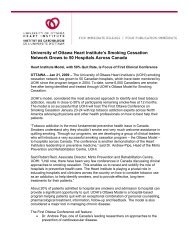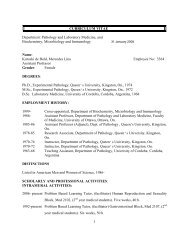Hand Washing Quiz 1. What is the primary purpose of hand hygiene ...
Hand Washing Quiz 1. What is the primary purpose of hand hygiene ...
Hand Washing Quiz 1. What is the primary purpose of hand hygiene ...
Create successful ePaper yourself
Turn your PDF publications into a flip-book with our unique Google optimized e-Paper software.
<strong>Hand</strong> <strong>Washing</strong> <strong>Quiz</strong><br />
<strong>1.</strong> <strong>What</strong> <strong>is</strong> <strong>the</strong> <strong>primary</strong> <strong>purpose</strong> <strong>of</strong> <strong>hand</strong> <strong>hygiene</strong><br />
a. To reduce microorgan<strong>is</strong>ms on <strong>the</strong> <strong>hand</strong>s<br />
b. To keep <strong>hand</strong>s clean<br />
c. To keep nails clean<br />
d. To maintain skin integrity<br />
2. Which <strong>is</strong> <strong>the</strong> preferred method for decontamination <strong>of</strong> <strong>hand</strong>s in a health care<br />
setting<br />
a. Bar <strong>of</strong> soap and running water<br />
b. Liquid soap and running water<br />
c. Alcohol-based <strong>hand</strong> rub (ABHR)<br />
d. Ant<strong>is</strong>eptic soap and running water<br />
3. After turning on <strong>the</strong> taps what <strong>is</strong> <strong>the</strong> next step when using <strong>the</strong> correct<br />
technique for washing <strong>hand</strong>s with soap and water<br />
a. La<strong>the</strong>r <strong>hand</strong>s<br />
b. Wet <strong>hand</strong>s with warm water<br />
c. Apply liquid soap<br />
d. Wet <strong>hand</strong>s with hot water<br />
4. The effectiveness <strong>of</strong> <strong>hand</strong> <strong>hygiene</strong> practices <strong>is</strong> most impacted by <strong>the</strong><br />
condition <strong>of</strong>:<br />
a. Fingertips, skin and nails<br />
b. Skin and nails<br />
c. Fingertips and skin<br />
d. Nails, hair and fingertips<br />
5. It <strong>is</strong> recommended that th<strong>is</strong> <strong>hand</strong> <strong>hygiene</strong> agent be used to routinely<br />
decontaminate <strong>hand</strong>s when <strong>hand</strong>s are not v<strong>is</strong>ibly soiled.<br />
a. Liquid soap<br />
b. Antibacterial bar soap<br />
c. Bar <strong>of</strong> bath soap<br />
d. Alcohol based <strong>hand</strong> rub<br />
6. Th<strong>is</strong> <strong>hand</strong> <strong>hygiene</strong> agent <strong>is</strong> appropriate for most <strong>hand</strong> washing and <strong>is</strong> used for<br />
most patient care when <strong>hand</strong>s are v<strong>is</strong>ibly soiled.<br />
a. Antibacterial bar soap<br />
b. Alcohol based <strong>hand</strong> rub<br />
c. Bar <strong>of</strong> bath soap<br />
d. Liquid soap
7. Th<strong>is</strong> <strong>hand</strong> <strong>hygiene</strong> agent <strong>is</strong> not acceptable in <strong>the</strong> health care setting except<br />
for personal patient use.<br />
a. Antibacterial bar soap<br />
b. Bar <strong>of</strong> bath soap<br />
c. Alcohol based <strong>hand</strong> rub<br />
d. Liquid soap<br />
8. <strong>What</strong> factors impact <strong>the</strong> effectiveness <strong>of</strong> <strong>hand</strong> <strong>hygiene</strong> practices<br />
a. The presence <strong>of</strong> jewellery<br />
b. Condition <strong>of</strong> skin<br />
c. Condition <strong>of</strong> nails<br />
d. All <strong>of</strong> <strong>the</strong> above<br />
9. Why should artificial nails not be worn by those giving patient care<br />
a. They are difficult to clean<br />
b. They can harbour more bacteria than short nails<br />
c. They can pierce gloves<br />
d. All <strong>of</strong> <strong>the</strong> above<br />
10. <strong>What</strong> <strong>is</strong> <strong>the</strong> minimum amount <strong>of</strong> time you need to rub your <strong>hand</strong>s with<br />
alcohol-based <strong>hand</strong> rub (ABHR) to kill most organ<strong>is</strong>ms on your <strong>hand</strong>s<br />
a. 3 seconds<br />
b. 10 seconds<br />
c. 15 seconds<br />
d. 1 minute<br />
1<strong>1.</strong> <strong>Hand</strong> <strong>hygiene</strong> <strong>is</strong> to be performed in which <strong>of</strong> <strong>the</strong> following situations:<br />
a. Before initial patient /patient environment contact<br />
b. After removing gloves<br />
c. Before aseptic procedures<br />
d. All <strong>of</strong> <strong>the</strong> above<br />
12. Which <strong>of</strong> <strong>the</strong> following statement on <strong>the</strong> technique <strong>of</strong> <strong>hand</strong> <strong>hygiene</strong> with an<br />
alcohol-based <strong>hand</strong> rub (ABHR) are true<br />
a. The <strong>hand</strong>rub has to cover <strong>the</strong> entire surface <strong>of</strong> both <strong>hand</strong>s<br />
b. <strong>Hand</strong>s have to be dry before care<br />
c. You can dry your <strong>hand</strong>s with a towel after <strong>hand</strong>rubbing
13. Which <strong>of</strong> <strong>the</strong> following should be avoided because <strong>of</strong> its association with a<br />
high likelihood <strong>of</strong> <strong>hand</strong> colonization<br />
a. Wearing jewellery<br />
b. Damaged skin<br />
c. Artificial fingernails<br />
d. Regular use <strong>of</strong> a hospital supplied <strong>hand</strong> cream d<strong>is</strong>pensed correctly<br />
14. Which <strong>of</strong> <strong>the</strong> following statements on alcohol based <strong>hand</strong> rub and<br />
<strong>hand</strong>washing with soap and water are true<br />
a. <strong>Hand</strong>rubbing <strong>is</strong> more rapid for <strong>hand</strong> cleansing than <strong>hand</strong>washing<br />
b. <strong>Hand</strong>rubbing dries <strong>the</strong> skin more than <strong>hand</strong>washing<br />
c. <strong>Hand</strong>washing <strong>is</strong> more effective against most organ<strong>is</strong>ms than<br />
<strong>hand</strong>rubbing<br />
15. Which <strong>of</strong> <strong>the</strong> following protects <strong>hand</strong> integrity<br />
a. Use <strong>of</strong> hospital approved mo<strong>is</strong>turizer frequently<br />
b. Soap and water <strong>is</strong> easier on skin integrity than alcohol based <strong>hand</strong> rub<br />
c. Wearing gloves over wet <strong>hand</strong>s protects skin<br />
d. Drying <strong>hand</strong>s carefully following washing protects skin<br />
16. Which <strong>of</strong> <strong>the</strong> following <strong>hand</strong> <strong>hygiene</strong> actions prevents cross-transm<strong>is</strong>sion <strong>of</strong><br />
organ<strong>is</strong>ms to <strong>the</strong> patient<br />
a. <strong>Hand</strong> <strong>hygiene</strong> immediately before an aseptic procedure<br />
b. <strong>Hand</strong> <strong>hygiene</strong> before initial patient / patient environment contact<br />
c. <strong>Hand</strong> <strong>hygiene</strong> immediately after a r<strong>is</strong>k <strong>of</strong> body fluid exposure<br />
d. <strong>Hand</strong> <strong>hygiene</strong> after patient / patient environment contact<br />
17. Which <strong>of</strong> <strong>the</strong> following <strong>hand</strong> <strong>hygiene</strong> actions prevents infection <strong>of</strong> <strong>the</strong> patient<br />
by h<strong>is</strong> or her own organ<strong>is</strong>ms<br />
a. <strong>Hand</strong> <strong>hygiene</strong> immediately before an aseptic procedure<br />
b. <strong>Hand</strong> <strong>hygiene</strong> before initial patient / patient environment contact<br />
c. <strong>Hand</strong> <strong>hygiene</strong> immediately after a r<strong>is</strong>k <strong>of</strong> body fluid exposure<br />
d. <strong>Hand</strong> <strong>hygiene</strong> after patient / patient environment contact
18. Which <strong>of</strong> <strong>the</strong> following <strong>hand</strong> <strong>hygiene</strong> actions prevents infection <strong>of</strong> <strong>the</strong> health<br />
care provider<br />
a. <strong>Hand</strong> <strong>hygiene</strong> immediately before an aseptic procedure<br />
b. <strong>Hand</strong> <strong>hygiene</strong> before initial patient / patient environment contact<br />
c. <strong>Hand</strong> <strong>hygiene</strong> immediately before putting on gloves<br />
d. <strong>Hand</strong> <strong>hygiene</strong> after patient / patient environment contact<br />
19. Which <strong>of</strong> <strong>the</strong> following <strong>is</strong> considered an ’aseptic’ procedure<br />
a. Ass<strong>is</strong>ting with oral care<br />
b. Preparing medications<br />
c. Doing a wound dressing<br />
d. All <strong>of</strong> <strong>the</strong> above<br />
20. Which statement or statements are true about glove use<br />
a. You should wear gloves at all times in <strong>the</strong> patient’s room<br />
b. Wear gloves only when indicted, o<strong>the</strong>rw<strong>is</strong>e <strong>the</strong>y can be a major r<strong>is</strong>k for<br />
transm<strong>is</strong>sion <strong>of</strong> organ<strong>is</strong>ms.<br />
c. You can wash your gloves with soap & running water but not alcohol<br />
based rubs


